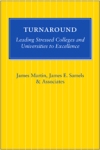Guest post by James Martin and James E. Samels
One of the many sins an author can commit is to be a “passenger” on the publishing journey of her or his own book. We have heard colleagues admit, “I just write the books; it is their job to sell them.” Or, “I just spent three years with that manuscript. I don’t have the time to market it, and I wouldn’t know where to begin.” For a book to be successful, however, the author and the publishing team have to work together–and that was a lesson it took us some time to learn.
We began our publishing life, we’ll have to admit, as passengers: conveniently thinking that our books would be marketed and sold as if by magic. We had produced a gold-medal work, after all, one that would travel a singular path to distinction, reading lists, prizes, maybe Oprah (back in the day). As we realized (sometimes painfully) these assumptions were false, we also discovered a new and rewarding role to play in relation to our hard-working friends at the Hopkins Press: “partner.”
An author who partners with the Press’s editorial, publicity, and marketing teams earns better results in sales and, as importantly, is likely to have a better publishing experience. In our observation, authors who are partners have learned at least six important things:
- Take time with the Author Questionnaire. The Press’s Author Questionnaire is a critical, foundational document both for initial sales and long-term success. Taking the time, no matter how much else is on one’s desktop, to fill it in completely and creatively earns greater respect and support.
- Professional associations are simply starting point. Many authors look favorably on speaking about their books at friendly association meetings in their discipline. However, the author partners learn, and leverage, the difference between a professional gathering and a gathering of professionals. They realize that almost any meeting of colleagues, whether in one’s discipline or not, is fair game to announce, discuss, and market a new book.
- Order forms lead to orders; business cards lead to relationships. At a launch reception for our current book that we had scheduled at our own cost, i.e., invitations, hotel room, food and beverages, our editor traveled from Baltimore to Boston and presented us with order forms, posters, Press catalogs, and business cards with the book’s cover and ordering information. No books were sold on that pre-publication evening, but several hundred future purchasers left with an order form for their offices and a business card for their wallets. The extra cards have all been put into service as stocking stuffers, ice-breakers, and appointment reminders.
- Keys, wallet . . . book! With our first book two decades ago, we urged the Publicity Department to send boxes of books to conferences where we were speaking. We had no concept of the cost, effort, and liabilities involved. Today, we accompany speaking engagements with a request to conference coordinators for an “Author’s Corner” time and table (tablecloths seem to increase interest). We bring two copies of our book—one for display, one for browsing—and order forms, business cards, and “table-top” posters to draw attention to both book and Press, all of which we carry to the event in one briefcase.
- You are the expert on your book, but your publicist is the expert on how you can help promote it. Ask questions. Listen to the advice and follow that advice. i.e., Don’t use jargon when speaking to reporters, a smile can be heard even on the radio.
- Tweet, tweet . . . If your editor is tweeting about your book and you are not, you still have work to do. The faster an author learns via tweets and blogs the value in writing about his or her work (after writing his or her work), the sooner he or she make the move from passenger to partner.
James Martin is a professor of English at Mount Ida College. James E. Samels is president and CEO of The Education Alliance, a higher education consulting firm. Their most recent book is The Provost’s Handbook: The Role of the Chief Academic Officer, which was just published. Their earlier books, all with Johns Hopkins, are Turnaround: Leading Stressed Colleges and Universities to Excellence; Presidential Transition in Higher Education: Managing Leadership Change; Merging Colleges for Mutual Growth: A New Strategy for Academic Managers; and The Sustainable University: Green Goals and New Challenges for Higher Education Leaders.





